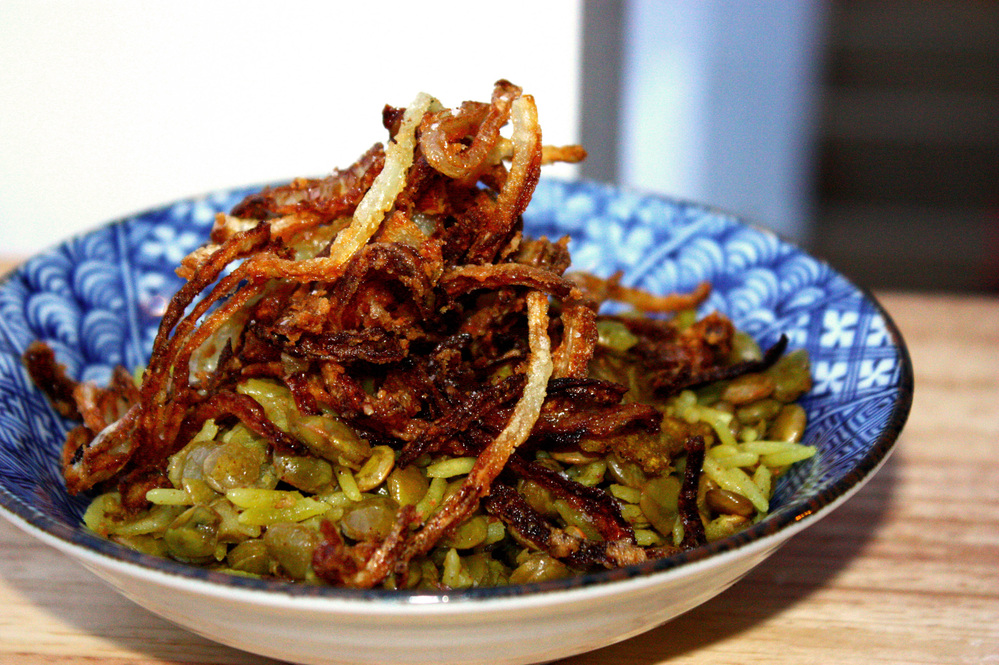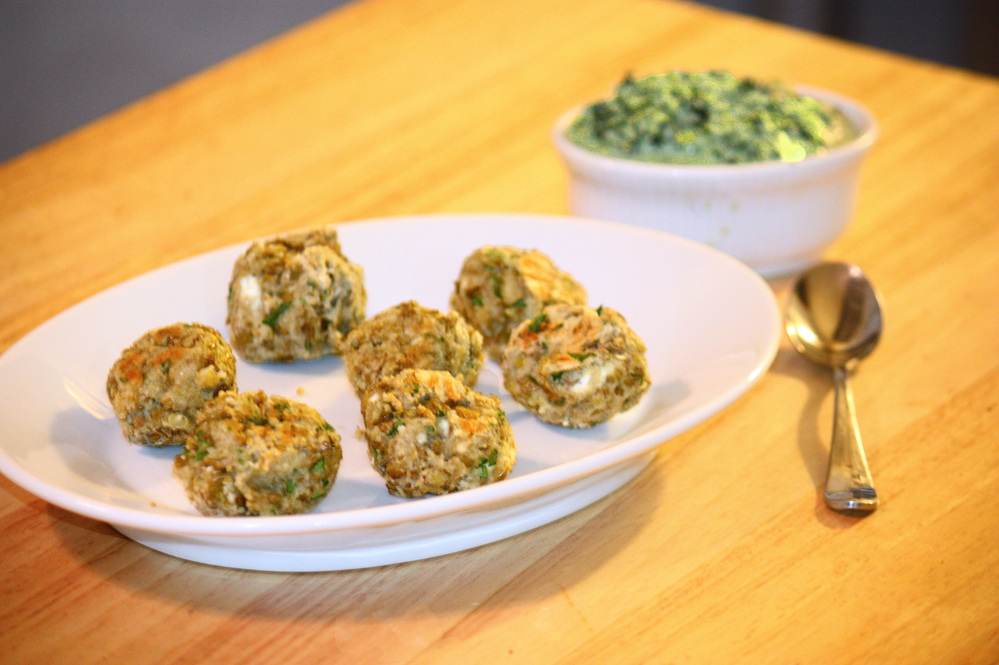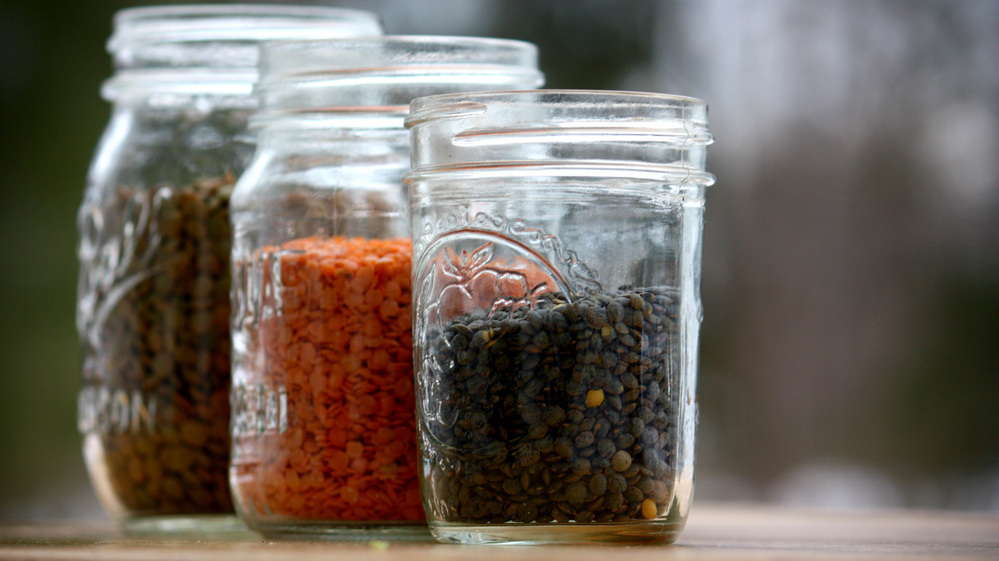The year I discovered lentils, I was broke and lonely and didn't know how to cook. Lentils, it turned out, would have gone a long way toward providing the solution to some of these problems. However, when I first had them, they were a mystery.
They also were the cheapest thing on the menu at the Middle Eastern deli around the corner. The dish was mudardara, I was told. "What's that again?" I said, unable to untangle the knot of plosive consonants. It was repeated.
I sat by the window, watching the rain trickle down the plate glass, and slowly ate what I couldn't pronounce: the rice, the lentils, the caramelized onions. At the time, it seemed like the best food in the world filling, nutty and earthen, the onions sweet and crisp on the edges. As I walked the block home, I muttered, "Muhdaahrderer, moojardarah, murdarjerer," stumbling over the rolled "r" in the middle and wondering how I would go about ordering it the next time.
I didn't know then that mudardara is as common as can be a staple found throughout the Arab world and is spelled mejadra and mjaddarah among others. Though it's thought to have originated in Persia, it's eaten everywhere between Greece and India, from North Africa to the Black Sea. Even if you have almost nothing, you can probably scrape together a handful of rice and a handful of lentils, and if you can do that, you have mudardara.
Like many other intrinsically boring foods say, tofu or grits lentils shine because they get out of the way. They provide a vehicle and a backdrop for other flavors whether it's good olive oil and gently gilded onions, or ground spices or minted yogurt. They provide a sturdy, comforting stage for a colorful cast of characters, from chaste cumin to tart sumac, brilliant lemon zest to cool cucumber.
It took me awhile to learn my away around the understated charm of lentils. I started with soup, which was a cinch to make. Dry lentils were another story. Eventually, after many tooth-cracking undercooked lentils, I learned to pan-steam them with rice into the corner deli's signature dish. I learned, too, that the flavor wasn't magic. It was onions, as is usually the case. It's said that Esau's mess of potage the one for which he sold his birthright was an early variation of mudardara. If it had fried onions, then I think I know how he felt.
Over the years, I have come to love lentils many different ways. I eat them in stews. I eat them seethed with bits of bacon or salt pork. I like them in cold salads. I especially like the red split lentils as a hot, spiced dal. I recently found a recipe that transforms them into "meatballs" airy, nutty, meatless ones.
Yet time and again, I return to that ancient blend of rice and legumes. It's not that I would sell my birthright (whatever that might be my father's name? my mother's good teeth?). But somehow, after eating my lentils, I always feel comfortably full, as if I could want for nothing. And if I can pass along to my children the know-how expressed in a dash of cumin, a handful of grains and a crisply dealt-with onion, surely that's an inheritance worth a good deal more than a hill of beans.
Recipe: Mudardara, Or Mejadra
This version comes from Jerusalem (10 Speed Press, 2012), the smashing cookbook by Yotam Ottolenghi and Sami Tamimi. It has lots and lots of fried onions. It's not a deep fry so much as a shallow fry, and the onions are so very, very good. If you don't want to fry, you can certainly caramelize the onions instead (using 3 tablespoons of oil and taking unhurried pains with the texture and the color).
 Enlarge image i
Enlarge image i 
Makes 4 servings
1 1/4 cups green or brown lentils
4 medium onions (1 1/2 pounds before peeling)
3 tablespoons all-purpose flour
1 1/2 teaspoons salt, divided
1 cup sunflower oil
2 teaspoons cumin seeds
1 1/2 tablespoons coriander seeds
1 cup basmati rice
2 tablespoons olive oil
1/2 teaspoon ground turmeric
1 1/2 teaspoons ground allspice
1 1/2 teaspoons ground cinnamon
1 teaspoon sugar
Freshly ground black pepper
1 1/2 cups water
Place the lentils in a small saucepan, cover with plenty of water, bring to a boil and cook 12 to 15 minutes, until lentils have softened but still have a little bite. Drain and set aside.
Peel onions and slice thinly. Place on a large flat plate, sprinkle with the flour and 1 teaspoon salt, and mix well with your hands. Heat sunflower oil in a medium heavy-bottomed saucepan placed over high heat. Make sure the oil is hot by throwing in a small piece of onion; it should sizzle vigorously. Reduce the heat to medium-high and carefully (it may spit!) add a third of the sliced onion. Fry for 5 to 7 minutes, stirring occasionally with a slotted spoon, until the onion takes on a nice golden brown color and turns crispy (adjust the temperature so the onion doesn't fry too quickly and burn). Use the spoon to transfer the onion to a colander lined with paper towels and sprinkle with a little more salt. Do the same with the other two batches of onion, adding a little extra oil if needed.
Wipe clean the saucepan in which you fried the onion, and put in the cumin and coriander seeds. Place over medium heat and toast the seeds for a minute or two. Add the rice, olive oil, turmeric, allspice, cinnamon, sugar, remaining 1/2 teaspoon salt and plenty of black pepper. Stir to coat the rice with the oil, then add the cooked lentils and the water. Bring to a boil, cover with a lid and simmer over very low heat for 15 minutes.
Remove from the heat, lift off the lid and quickly cover the pan with a clean tea towel. Seal tightly with the lid and set aside for 10 minutes.
Finally, add half the fried onion to the rice and lentils and stir gently with a fork. Pile the mixture in a shallow serving bowl and top with the rest of the onion.
Recipe: Lentil Meatballs With Lemon Pesto
These meatballs, from Sara Forte's The Sprouted Kitchen (10 Speed Press, 2012), are surprisingly light in texture, though robust in flavor. Don't skip the pesto, as it makes the dish if Meyer lemons are not to be had, regular lemons will do.
 Enlarge image i
Enlarge image i 
Makes 4 servings
1 cup lentils, rinsed
2 cups water
2 large eggs, lightly beaten
1 tablespoon extra-virgin olive oil
3/4 cup ricotta
1/4 cup freshly grated Parmesan cheese
2 cloves garlic, minced
1/2 teaspoon fennel seeds
2 tablespoons chopped fresh flat-leaf parsley
A few pinches of fresh thyme leaves or dried thyme
1 teaspoon sea salt
1 teaspoon freshly ground pepper
2/3 cup breadcrumbs
Lemon Pesto Sauce
1 clove garlic
1/4 cup pine nuts
Grated zest and juice of 1 Meyer lemon
Pinch of sea salt
1 cup packed fresh basil leaves
1/4 to 1/3 cup extra-virgin olive oil
2 tablespoons freshly grated Parmesan cheese
2 tablespoons water
Put the lentils in a pot with the water and bring to a gentle boil over medium-high heat. Reduce the heat to a simmer and cook, uncovered, until the lentils are tender, 15 to 20 minutes, adding water if the liquid has evaporated and the lentils are still tough. Drain the lentils and set aside to cool.
Transfer the lentils to a food processor and pulse until a chunky puree forms. Transfer to a large mixing bowl and add the eggs, olive oil, ricotta, Parmesan, garlic, fennel seeds, parsley, thyme, salt and pepper. Stir to combine well. Stir in the bread crumbs and let sit at room temperature for 15 minutes to allow the flavors to blend.
Preheat the oven to 400 degrees, and line a rimmed baking sheet with parchment paper. In the meantime, make pesto. In a food processor or mini blender, blend the garlic, pine nuts, lemon zest and juice, and salt until smooth.
Add the basil, 1/4 cup of olive oil and Parmesan, and pulse again until smooth, adding more olive oil as needed to smooth it out, and a bit of water as needed to get a thinner, saucelike consistency.
Check the lentil mixture by rolling a 1-inch ball together between your palms; it should hold together fairly well. If it seems too wet, add another tablespoon or two of the breadcrumbs to the mixture. Roll the lentil mixture into 1-inch balls and arrange them on the prepared baking sheet. They don't need a lot of space between. If you like a bit more of a crust, give them a thin brush of olive oil. Bake until the tops are golden brown, gently turning the balls over halfway through, 15 to 20 minutes. Remove to cool slightly.
Serve with a drizzle of pesto sauce.
Recipe: Red Lentil Dal
This very traditional recipe originally came from a family friend, Rohini Nilekani. I like it best with red split lentils (masoor dal), although yellow lentils (moong dal) also are good. You can find them at many natural foods stores, as well as online and at Indian groceries. The latter are your best bet for the harder-to-find items, such as fenugreek and curry leaves.
Makes 4 servings
1 1/2 cups red split lentils (masoor dal) or yellow lentils
3 tablespoons olive or vegetable oil
1 tablespoon black or brown mustard seeds
2 teaspoons fenugreek seeds
2 teaspoons cumin seeds
2 medium onions, finely chopped
1 or 2 small fresh green chili peppers (e.g. Thai bird chilies), finely chopped
10 to 12 curry leaves
4 tablespoons tomato paste
2 teaspoons ground coriander
Pinch of turmeric
Pinch of cayenne
1 teaspoon ground fennel seeds
Cilantro sprigs to garnish
Cooked rice
To cook the dal, place the lentils in a medium saucepan and cover with water by about 2 inches. Bring to a boil, reduce the heat and simmer, stirring often, until the dal forms a loose, tender mass (or until it achieves the texture you prefer), about 15 to 20 minutes depending on the age of the dal. Salt to taste.
In a heavy skillet, heat the oil over a medium-high flame until it shimmers. Grab a splatter screen or cover and add the mustard, fenugreek and cumin seeds to the pan (the mustard seeds will instantly begin to pop, so wield the splatter screen wisely). Before the popping ceases, add the chopped onions, chili peppers and curry leaves, and reduce the heat to medium. Gently cook the onion mixture until the onions have softened and show a pale gold, stirring as you go and checking for salt, about 15 minutes.
Add the tomato paste and stir to amalgamate. If the onion-spice mixture is very dry and stiff, add water to loosen it until aromatic and slightly wet. Add the coriander, turmeric, cayenne and fennel and stir to mix. Add the cooked dal with salt to taste, and cook very gently until just married, turning off the heat before the pan dries out.
Garnish with cilantro and serve with rice.
 Enlarge image i
Enlarge image i 
No comments:
Post a Comment